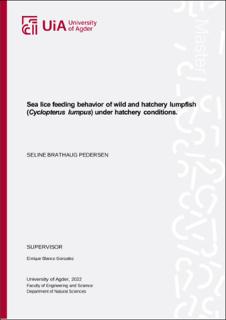| dc.description.abstract | In 2014 Norway contributed 1.2 million tons of the world production of farmed salmon. Norway is the world’s largest producer of farmed salmon, and the species is among the top five species, quantity consumed, in the major seafood markets. Infection by sea lice is the greatest disease challenge currently limiting the production of Atlantic salmon globally. Sea lice are responsible for a wide range of distresses to the fish, from mild skin damage to stress-induced mortality, which can be a tremendous economic burden for the Atlantic farmed industry. Biological control by cleaner fish has become a common approach to delouse salmon. Lumpfish is a cold-water marine fish used as cleaner fish, and salmon cages contain 93%-97% fewer sea lice with lumpfish present than without them. The use of lumpfish as biological control raises ethical concerns for poor welfare and high mortality of the cleaner fish when stocked in sea cages. Good welfare of lumpfish is essential because it affects their ability to delouse salmon, and a higher welfare will have several advantages, including improving delousing efficacy and having economic value as sea lice cause economic losses to the industry. There are few studies on the effectiveness of cleaner fish, and it is essential to characterize the behavior of individuals eating most actively on sea lice so that choosing lumpfish as cleaner fish in the future can be more efficient. The primary aim of this study was to observe feeding behavior of wild and hatchery lumpfish. This was done by comparing number and type of attacks by wild versus hatchery lumpfish to delouse salmon under hatchery conditions. Stomach content from gastric lavage was also used to examine how many lice were eaten by lumpfish. A secondary aim was to evaluate the swimming activity of wild and hatchery lumpfish under two different light conditions; 1) once lights are turned on, and 2) once the lights start dimming. Four swimming activities will be evaluated which are 1) hovering, 2) swimming, 3) attached swimming, and 4) burst swimming. Ten hatchery and ten wild lumpfish were introduced together with eight sea lice-infested salmon of approximately 300 g in a 500 l tanks over a 3-weeks experimental period. The experiment was duplicated in another 500 l tank. The number and type of attacks and the swimming activity of the lumpfish were recorded for posterior video analysis. Additionally, the number of sea lice consumed by each lumpfish was examined by a gastric lavage three times over the experimental period. Hatchery lumpfish seemed better fit for delousing based on the higher number of sea lice in their stomach, 55 lice compared to 27 by wild individuals, and a higher number of attacks recorded. Five individuals were evaluated more closely, because they had the highest number of attacks performed and highest number of lice in their stomach. The individuals were shown to have 5 to 23 sea lice in their stomach on total days sampled and performed attacks within most of the attack types. Hatchery lumpfish showed to be bolder and more aggressive than wild lumpfish. | |
